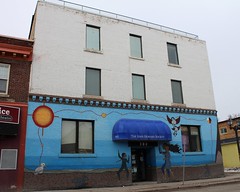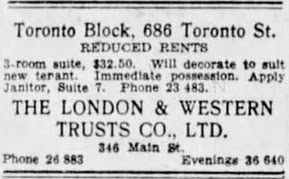The apartment block at 686 Toronto Street near Wellington Street is up for sale. The seller and eventual buyer likely have no clue that this building was once known to every Manitoban as the last place of freedom for a notorious bank robber and murderer.
The Burriss Block, as it was then called, was constructed in 1913, replacing a rooming house on that site named Hyldigunn. Its first roster of tenants was typical of any middle class building:
Suite 1 - The Thomas family. Parents Gudjon (jeweler) and Caroline (music teacher), along with their children Jonina (teacher) and Solveig (student). Suite 2 - Charles Reid, a CPR engineer. Suite 4 - Frank Holt, shipper, and Patrick Garrity, teamster, both at Security Storage Ltd. on Ellice Avenue. Suite 6 - Albert Johnson, a clerk at W H Stone Ltd, grocers. Suite 7 - Harrison "Had" Phillips, agent for Wood Vallance hardware company and he block's caretaker.
Krafchenko's final robbery took place on December 3, 1913. He entered the Bank of Montreal in his home town of Plum Coulee and got $4,200 in cash, (about $100,000 in today's money). As he was felling, he turned and fired his gun at bank manager Henry Arnold. The shot killed him.
A manhunt ensued and Krafchenko was captured in an apartment on College Avenue in Winnipeg.
The rope he used to shimmy down the side of the building broke, sending him 30 feet to the pavement below. With an injured back, badly sprained ankle, and assorted cuts and bruises, he hobbled down William Avenue. Krafchenko later told police that a friendly motorist noticed him and offered a ride to his destination: 686 Toronto Street.
A man name Westlake, whom Holt had known for a number of years, wrote to say he was coming to the city and asked if he could stay for a while. Holt agreed. He did not know that Westlake had once worked for Krafchenko's lawyer and was coming to help get Krafchenko out of town.
Holt said that he only knew of the Krafchenko escape plan on Westlake's first evening in town when he told Holt was he was in town to do. Holt, unsure if Westlake was telling the truth or not, was in bed when he heard a knock at the door around 11:00 pm. It was Krafchenko.
The injury to Krafchenko wasn't part of the plan and Holt was told he'd have to put up with his two house guests until Krafchenko recovered from his injuries. By this time, Garrity the roommate, was also aware of what was going on.
The next morning, Holt and Garrity went to work as usual but made arrangements stay over at a suite on Beverley Street. They went back to Toronto Street periodically to pick up clothes but did not sleep there while Krafchenko recovered.
Krafchenko's injuries were not getting any better after the third day and and Westlake began to panic. He asked Holt to help find him a place to hide Krafchenko at the Security Storage building. On the night of January 14th he was smuggled into the building through the coal chute.
After a couple of days it was Holt's turn to panic. He went to Westlake to demand that Krafchenko be moved back to the Toronto Street apartment, which he was.
On the night of January 18, 1914, an informant gave police a tip about Krafchenko and the Security Storage escape plan. Dozens of officers, including police chief Donald MacPherson, descended on the building around 8:30 pm. The commotion brought out nearly 1,000 onlookers according to the Free Press.
Police searched the building, but found no sign of Krafchenko. They must have then searched employee records, as the police chief rushed from the building back into his car and sped off with other police cars and reporters in tow. They arrived at the Burriss Block at 11:08 pm..
Suite 4, where Krafchenko was holed up, was described as the Free Press as diminutive and sparsely decorated. Krafchenko's room contained a couch bed, a dresser and two chairs. One chair had a pack of matches, packet of tobacco, and a candle, (for some reason the power in the building was out that night). There were several copies of the newspaper strewn around the room.
A Winnipeg Tribune reporter who claimed to have been in the building at the time of the arrest said that Chief MacPherson led a group of officers to the door of suite 4. They entered to find Krafchenko, gaunt, unshaven and bandaged, sitting on the couch smoking a cigarette.
The Tribune reports a typically Canadian arrest scenario. MacPherson said to the unarmed fugitive "Play fair, Jack, and we'll play fair with you." Krafchenko is said to have replied "I'm all in. I don't want any shooting, boys." The two then shook hands and MacPherson placed him under arrest. The police then had to help the injured man to the police car that whisked him off to Headingley Jail's highest security cell.
Percy Hagel, Krafchenko's lawyer, assembled the crew and was sentenced to three years in prison. After his release, he returned to practising law.
Constable Robert Reid, a policeman who worked at the jail and smuggled in the gun and rope used by Krafchenko to escape, was sentenced to seven years at Stoney Mountain. While serving his sentence, he became ill and died.
John Westlake was sentenced to two years for his involvement.
J. H. Buxton, a local businessman and former secretary of the Builder's Exchange, procured the gun and rope used by Krafchenko. It turns out that he was also informant who came forward to police that led to the capture of Krafchenko. Later, he gave a full statement outlining the plan and who was involved. For his role, Buxton, originally from the U.S. was put into an early version of "witness protection" - and relocated to the state of Maryland.
Frank Holt was given a suspended sentence. The judge and Crown felt that he only went along with the plan out of fear for his safety if he had "squealed'.
Krafchenko was found guilty and was hanged on July 9, 1914 at the Vaughan Street Jail in Winnipeg at the age of 33. He left behind a wife and infant child.
As for the Burris Block, its name was sullied just months after it had opened. Subsequent "for rent" ads referred to it only as 686 Toronto Street. In the 1930s, it was rechristened the Toronto Block, a name that still appears above the door.
A scan through the Winnipeg Free Press archives show that it has had a quiet, uneventful existence ever since the arrest of "Bloody Jack".

Krafchenko wanted poster at Winnipeg Police Museum
Also visit the Winnipeg Police Museum for artefacts about the case
























8 comments:
Great story Christian! We live behind this block and I've always been curious about it. There used to be 3 plaques up at the very top stating "19", "A.D." and "13", but the 19 and the 13 have been covered up in the last 20 years. Do you know why?
I love this story; found it by googling. May not have found it if you hadn't spelled Krafchenko correctly at least once... There are at least 4 different spellings of the name in this article!
Thanks. I will change them all to one. The different spellings were an issue back in the day. I came across numerous incarnations of it through years of newspaper articles!
Done! A couple were plain, old typos. i see I posted that at 4:08 am that day so wasn't at my best for proofreading !
The person that was murdered was a relative of mine, Mr. Henry Arnold.
Dianne - please contact me. I am researching a book on Krafchenko. billp@sbrc.ca
Wow! I lived in that very apartment as a teenager during 1987-89 with my mom and little sister. The place was so cramped but cozy.
Dianne... My email has since changed to Nachraligre01@gmail.com
Post a Comment